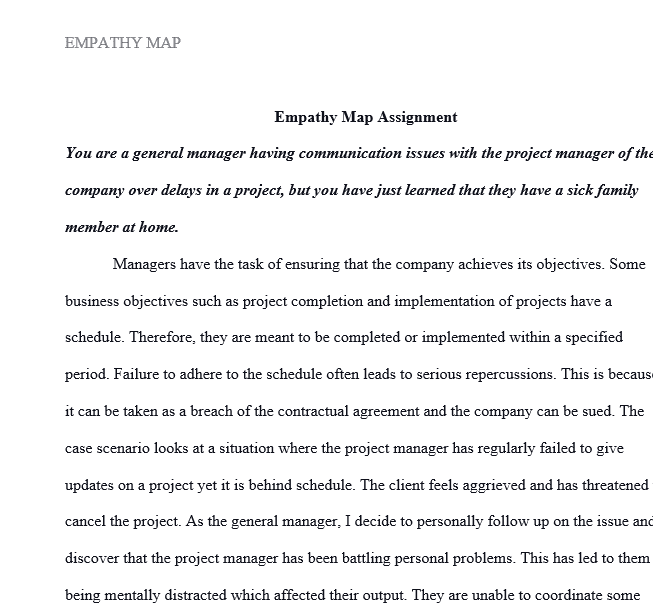You are an employee who saw a change in your coworker’s performance but learned that they are having family issues that are affecting them at work.
Assignment: Empathy Map
coca cola
Assignment Description
After viewing the video by Simon Sinek on empathy, located in the learning materials section of this module, we can have a greater idea of empathy. As Mr. Sinek suggests, we have to start practicing empathy and relate to what others may be going through and it will profoundly change the decisions we make. It will profoundly change the way we see the world. The video combined with the assignment below is a great exercise in developing an understanding of others; whether it be coworkers, the manager, or even clients/customers.
Empathy Map (designed by David Gray of XPLANE and author of The Connected Company and Gamestorming). (Links to an external site.)Note: Professor Ramsey was given permission by Mr. Gray to utilize this map via email where he also expressed interest in seeing what students come up with for this exercise!
Empathy Map is a template designed to help development teams gain a deeper level of understanding of an internal or external stakeholder, such as a customer, a prospect, a partner or a peer in your own company. Even if you don’t understand the stakeholder very well, the empathy-mapping exercise can help you identify gaps in your understanding and help you gain a deeper understanding of the things you don’t yet know.
Instructions: Students can use this map as if they are a manager trying to have empathy for an employee, or for a client. It can also be viewed as an employee having empathy for a co-worker or even the boss. To take it a step further, it may also put you in the shoes so to speak of a company’s board of directors, executive management, shareholders, creditors, suppliers, and the local community.
Assignment Instructions
Select an issue facing a company today (i.e. pandemic, social injustice, etc.) and fill out the empathy map with one of these scenarios in mind:
You are a manager trying to have empathy for one of your employees during this time who is personally affected by this issue.
You are a board member having a communication issue with a manager of the company, but you have just learned that they have a sick family member at home.
You are an employee who saw a change in your coworker’s performance but learned that they are having family issues that are affecting them at work.
Design your own scenario that you would like to use to complete this exercise.
How to use the Empathy Map?
Start with the GOAL section, by defining who will be the subject of the Empathy Map and a goal: something they need to do. This should be framed in terms of an observable behavior. Additionally, provide an example of a strategic or non-strategic decision this person could make as it relates to the company’s product or service.
Once you have determined the goal, work clockwise around the map. The reason for this is to give you a chance to imagine what another’s experience might be like.
After the outside elements have been determined, then the focus can shift to the large head within the diagram. (This is one of the most important aspects of the map’s design; what it’s like to be inside someone else’s head.
A completed Empathy Map exercise is a great addition for a value proposition design if one is designing the customer experience, products, or services.
Options: Students can either print out the map, write legibly on it, then upload to this assignment, or type out the answers to the questions listed on the PDF template and submit in a Word document, making sure to separate each of the seven sections so as to make it easier to organize.
Solution preview for the order on You are an employee who saw a change in your coworker’s performance but learned that they are having family issues that are affecting them at work.
APA
928 words
